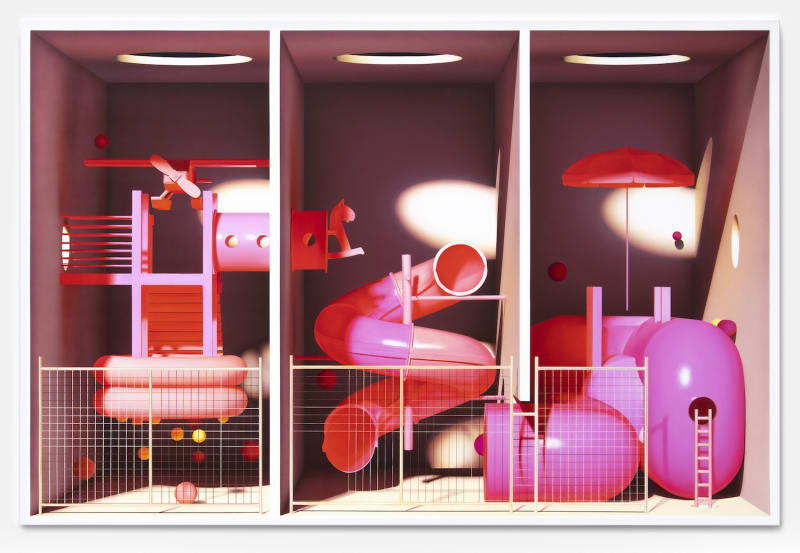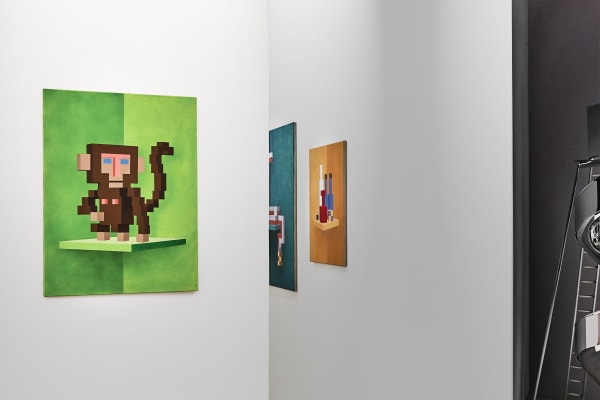Asal Peirovi, Sepand Danesh, and Mehdi Ghadyanloo: ART021 2020
Dastan is pleased to announce its second participation at ART021 with a presentation of works by Asal Peirovi, Sepand Danesh, and Mehdi Ghadyanloo at booth E31. This presentation features a number of acrylic paintings on linen by Asal Peirovi, large scale acrylic and oil paintings on canvas by Mehdi Ghadyanloo, and cube-based three-dimensional works by Sepand Danesh.
The ART021 Shanghai Contemporary Art Fair will be held in Shanghai, China on 12-15 Nov 2020.
Opening Date (2 days of private viewing): November 12 and 13, 2020
Opening Date to Public: November 14, 2020 - November 15, 2020
-
 Installation View of Dastan's Booth at ART021 2020.
Installation View of Dastan's Booth at ART021 2020. -
 Installation View of Dastan's Booth at ART021 2020.
Installation View of Dastan's Booth at ART021 2020. -
 Installation View of Dastan's Booth at ART021 2020.
Installation View of Dastan's Booth at ART021 2020. -
 Installation View of Dastan's Booth at ART021 2020.
Installation View of Dastan's Booth at ART021 2020. -
 Installation View of Dastan's Booth at ART021 2020.
Installation View of Dastan's Booth at ART021 2020. -
 Installation View of Dastan's Booth at ART021 2020.
Installation View of Dastan's Booth at ART021 2020. -
 Installation View of Dastan's Booth at ART021 2020.
Installation View of Dastan's Booth at ART021 2020. -
 Installation View of Dastan's Booth at ART021 2020.
Installation View of Dastan's Booth at ART021 2020. -
 Installation View of Dastan's Booth at ART021 2020.
Installation View of Dastan's Booth at ART021 2020. -
 Installation View of Dastan's Booth at ART021 2020.
Installation View of Dastan's Booth at ART021 2020. -
 Installation View of Dastan's Booth at ART021 2020.
Installation View of Dastan's Booth at ART021 2020.
Dastan is pleased to announce its second participation at Art021 with a presentation of works by Asal Peirovi, Sepand Danesh, and Mehdi Ghadyanloo at booth E31. This presentation features a number of acrylic paintings on linen by Asal Peirovi, large acrylic and oil paintings on canvas by Mehdi Ghadyanloo, and cube-based three-dimensional works by Sepand Danesh.
Asal Peirovi (b. 1985, Sari, Mazandaran Province, Iran) is a graduate of Painting from Shahed University (BA, 2009) and Tehran Art University (MA, 2014), currently living and working in Tehran. Her work has been featured in solo exhibitions at Dastan’s Basement, Standard Oslo, and Shirin Art Gallery. In her paintings, she employs a wide variety of techniques and explores themes of memory, travel, scenography, and geometry. Asal Peirovi’s “Curtains”, a series of acrylic paintings on linen, are a combination of study and improvisation in which the artist’s creation of visual texture on fabric resembles the unpredictable behavior of nature —an opportunity she uses as a context to add different layers of architectural elements standing in opposition to nature’s unpredictability. These architectural elements, inspired by historical Islamic-Persian structures and depicted in the color palette and the perspective techniques of traditional Persian painting, invoke a myriad of elusive references that express the diversity which informs Asal Peirovi’s visual perception.
Mehdi Ghadyanloo (b. 1981, Tehran, Iran) is a graduate of Painting (BA, University of Tehran, 2005) and Filmmaking (MA, Tarbiat Modares University, 2007), currently living and working in London, UK. Ghadyanloo’s works have been exhibited at numerous international galleries, including Galleri Golsa, Oslo and Howard Griffin Gallery, London. In 2016, he completed a large mural for the Rose Kennedy Greenway project in Boston, MA, USA. His most recent public art project was a 186-square-meter triptych painting titled “Finding Hope” that was shown at the World Economic Forum 2019 in Davos, Switzerland. While with his works, he presents an autobiographical view that portrays his personal childhood landscapes and recollections of Iran-Iraq war (1980-1988), he explores his direct experience of the world he is living in. Ghadyanloo’s most recent works show everyday objects —such as a slide that he comes across as he takes his kids to the local playground— and explore the physical presence of reality. As the artist explains: “...these works included reference-evoking memories of living in small and dimly-lit cubic rooms where my family would find refuge during the war.”
Sepand Danesh (b. 1984, Tehran, Iran) is a graduate of the École Nationale Supérieure de Beaux-Arts de Paris (2010), currently living and working in Paris, France. His works have been exhibited at numerous galleries and art institutions, namely the FRAC of PACA and Poitou-Charentes (2017), Galerie des Grands Bains Douche de La Plaine in Marseille (2016), Musée des Arts Décoratifs de Paris (2016), Mac/Val (2015), and the Cité des Arts de Chambéry (2014). In the paintings of Sepand Danesh, stories, myths and legends are mixed in a jumble of cubes, assembled in corners without floors or ceilings. The cube form takes the role of a universal alphabet incarnating a wide range of human emotions. In his assembled and painted cube-based sculptures, Sepand Danesh brings his paintings to life. The pixelated appearance of the characters requires an effort of reconstruction by the viewer who should virtually assemble the fragments to recognize the shapes. The snake is made to draw the eye to the tail as its alert gaze is plagued by an out-of-frame presence. The monkey is in a posture of both restlessness and support. He looks out but by his double posture gives the impression that he is more preoccupied with something inside. The still life is inspired by the work of Giorgio Morandi and the painting shows everyday objects inhabited by an exterior presence that placed them there.















